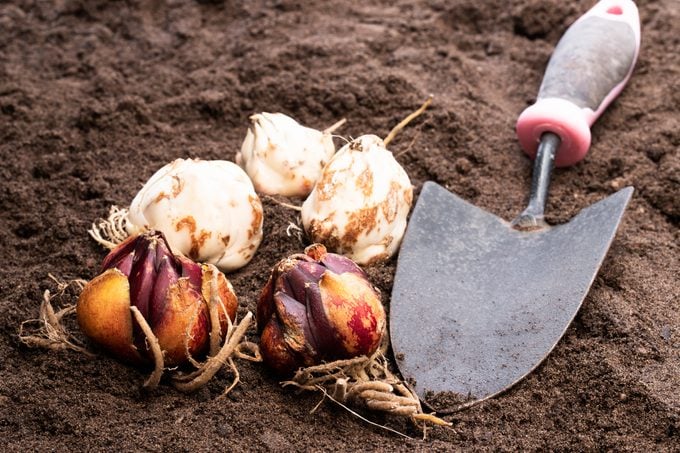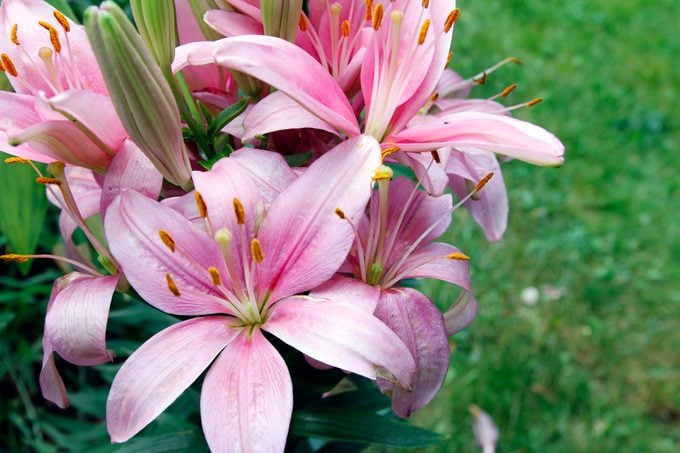The Best Time and Place to Plant Lily Bulbs
Updated: May 30, 2023
Is spring or fall planting better for abundant lilies? Discover the pros and cons of planting lily bulbs in spring vs. fall and the best way to care for them.
Most gardeners are aware that bulbs like tulips and daffodils should be planted in fall, but lily bulbs are a special case. You can find lily bulbs sold in both fall and spring. So which planting season is better, and how should you grow them?
Discover 4 types of flower bulbs that gardeners should grow.
When to Plant Lily Bulbs

According to horticulturist Vanessa Elms, owner of Old House Gardens, either fall or spring is fine. But fall is a little more forgiving if you can’t plant the bulbs right away.
“Lilies purchased in springtime have been stored all winter in a temperature-controlled setting and are very eager to get growing,” she says. “Fall planted bulbs are more dormant and are best planted ASAP but we have had good success planting them later in November (we are in zone 6a).”
From Elm’s observation after planting the same variety both seasons, spring planting gives you a stronger start and faster blooms.
“For the fall-planted bulbs, we see a modest display of flowers the next year and the height of the plant will not be the standard height of that variety,” she says. “For the spring planted bulbs, we see more successful first-year flowering in the summer-blooming lilies.”
True lily vs daylily: what’s the difference?
Where to Plant Lily Bulbs

Lilies prefer a sunny but not overly hot location, so if planting in the South look for a spot with afternoon shade. Give them some space from their neighbors for air circulation—approximately 9 to 18 inches apart depending on the lily’s ultimate size.
Their ideal soil is well-drained, fertile, and humusy, Elms says, so if you have clay soil, amend or plant in raised beds. The drainage is probably the key factor, she says. Overly wet soil risks rotting the bulbs before you can enjoy them. While adaptable, most prefer their soil slightly acidic. Tiger lilies (Lilium lancifolium or Lilium tigrinum) and Henry’s lily (Lilium henryi) thrive in neutral to alkaline soil.
Be generous while digging your hole for each lily. Plant them deep—three or four times the height of the bulb in soil. That deep planting helps keep the bulbs from drying out. Topping with mulch during spring and summer helps shade the lily bulbs’ roots. In cold climates, a winter mulch is helpful to prevent frost damage after waking up too early.
Special note: While Elms says in her experience, pets aren’t attracted to eating lilies, all parts of the plant contain compounds toxic to cats. She recommends if your pet samples your foliage regularly, to site them out of reach, including if you bring them inside to adorn your table.
Learn how to grow and care for Asiatic lily plants.
Lily Bulb Care Tips

Because lilies dislike being wet for very long, make sure not to love them too much when it comes to watering. In most cases, consistent rainfall should suffice to nourish your lily bulbs, but if the weather is excessively dry, take some time to water.
When lilies are happy, they naturalize, making smaller bulbs on the side of the original “mother bulb”. The original bulb eventually declines in strength as the new ones grow. You’ll see it put out smaller flowers over the years. Dividing every two or three years not only expands your lily patch but invigorates your bulbs.
If you want to relocate or divide your lily bulbs to a new spot in the garden, it’s best to wait until after the blooming season. “Ideally, after Labor Day is best for splitting and dividing your established plants,” Elm says.
Then, you simply dig up your lily bulbs, pull apart the side bulblets and discard the remnants of the oldest bulb. Replant three to four times as deep just as you did originally. You’ll be awash in blooms in no time!
Next, check out lovely pictures of lilies you need to see.




















